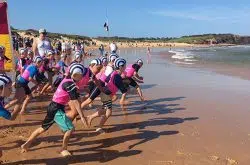Sport, leisure and recreational activities are the most common cause of dental injuries. And every year thousands of people are treated for dental injuries that could have been avoided by wearing a custom-fitted mouthguard, writes dentist Karlien Roper.
Why do you need a mouthguard?
Here are six reasons why it’s wise to wear a mouthguard while playing sport.
- It prevents laceration and bruising during impact – it acts as a buffer between the soft tissue of the lips and cheeks and the harder teeth.
- It protects teeth and bone in the upper and lower jaws from seismic contact with each other.
- It prevents tooth fractures or dislocations by cushioning the teeth from direct frontal blows while distributing the forces of an impact.
- It helps reduce neurologic injury by acting as a shock absorber between the upper and lower jaws.
- It fills edentulous spaces (areas that lack teeth) and thereby help to support adjacent teeth.
- It helps prevent neck and jaw injuries.
Types of mouthguards
Mouthguards are available in three basic types.
- Stock mouthguards – Readily available and the least expensive, they are also the least effective of the three. These mouthguards provide only a low level of protection. They do not seat well, which also imposes the risk of airway obstruction should a wearer become unconscious while playing sport.
- Boil-and-bite mouthguard – Most commonly used, the downside is that these mouthguards do not provide the proper thickness, comfort or critical protection of the posterior teeth. Often because of the inaccurate fit, kids have to clench in order to hold them into position.

- Custom-fitted mouthguards – These provide comfort, correct thickness and maximum protection for all teeth, including the posterior teeth.

The Australian Dental Association strongly recommends investing in a custom-fitted mouthguard from your dentist.
How to look after your mouthguard
- Rinse under running water after use and air-dry before placing it in an air-vented holder.
- Remember to give it a good brush with your toothbrush at home each time before you use it.
Tips for dealing with dental trauma on game day
Remember, a head injury may bleed A LOT due to its high vascular supply. Try to stay calm. Add pressure on the source of bleeding using fingers or clean gauze.
If a tooth is displaced, try to move it back into alignment and go to a dentist ASAP.
If a permanent tooth is knocked out…
- Locate it. Look for it in clothes and on the field. Was it swallowed? Is it inside the socket?
- Once found, rinse the tooth. Milk or saline solution is the best medium to use. If this is not available, use the child’s saliva to rinse the tooth.
- Place it back into the socket (let child bite down on a clean handkerchief to keep it in place). If you cannot get it back into the socket, keep it submerged in the wet medium inside a bag till you make it to the dentist. This will encourage the best possible outcome.
For more information on mouthguards and protecting teeth, visit the Australian Dental Association.
Does your child wear a mouthguard while playing sport? Or is it something you hadn’t considered before? We’d like to hear your thoughts in the comments section below.
More on child safety…












